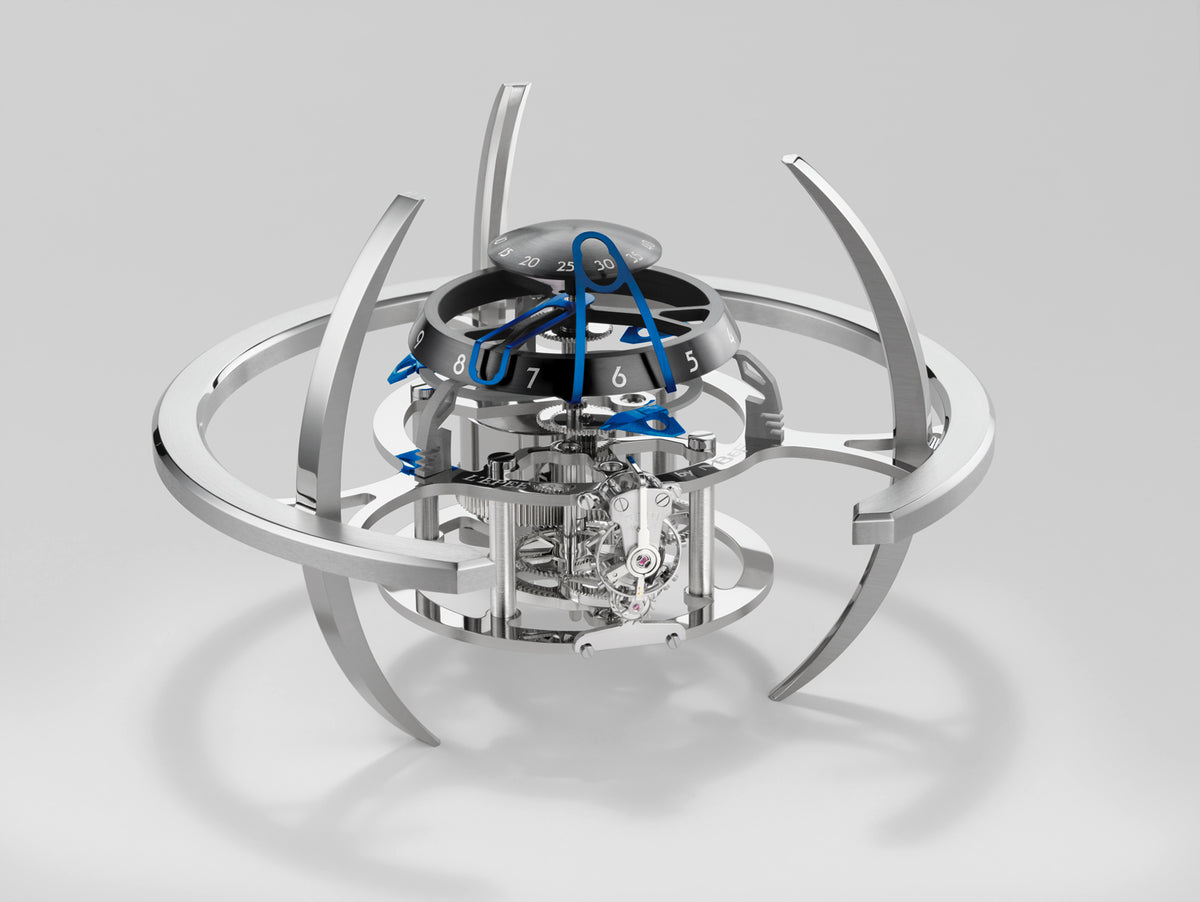

Minutes are indicated on a revolving disc, read off when they appear through the centre of a fixed metal aperture. The hours ring placed just below remains motionless; a hand indicates the hour by spinning in its place and performing a complete turn around the ring in 12 hours.
Starfleet Explorer also features an original new element in the form of three tiny spacecraft, lined up along the same axis at regular intervals and placed around the movement, the heart of the mechanism: they revolve continuously at a rate of one full turn every five minutes. A space exploration guided by the mothership.
The Starfleet Explorer’s movement is placed horizontally, but its escapement is vertically positioned. The impeccably finished stainless steel or palladium-treated brass components (with the exception of the 11 jewels) are designed and manufactured in the workshops of L’Epee 1839. The gears and mainspring barrel are on full display thanks to the skeletonised mainplate and concentric C-shaped external structure. The Starfleet Explorer can rest on both ends of its vertical landing gear; a useful feature when turning it over to wind the mainspring and set the time. It can also be leant sideways so as to offer a different view of the intergalactic horological station.

Dedicated to making high-end clocks, L'Epée has been a prominent Swiss Manufacture for over 180 years. Founded in 1839 by Auguste L’Epée in France’s Besançon region, the company originally focused on producing music boxes and watch components. The brand was synonymous at the time with entirely hand-made pieces.
From 1850 onwards, the Manufacture became a leading light in the production of ‘platform’ escapements, creating regulators especially for alarm and table clocks, as well as musical watches. It became a well-known specialist owning a large number of patents on exceptional escapements and the chief supplier of escapements to several celebrated watchmakers of the day. L'Epée has won a number of gold awards at international exhibitions.
L'Epée 1839 is now based in Delémont in the Swiss Jura Mountains. Under the impetus of its CEO Arnaud Nicolas, it has developed an exceptional table clock collection, encompassing a full range of sophisticated clocks. All models are designed and manufactured in-house. Their technical prowess, combination of form and function, very long power reserves and remarkable finishes have become signature features of the brand.
Dedicated to making high-end clocks, L'Epée has been a prominent Swiss Manufacture for over 180 years. Founded in 1839 by Auguste L’Epée in France’s Besançon region, the company originally focused on producing music boxes and watch components. The brand was synonymous at the time with entirely hand-made pieces.
From 1850 onwards, the Manufacture became a leading light in the production of ‘platform’ escapements, creating regulators especially for alarm and table clocks, as well as musical watches. It became a well-known specialist owning a large number of patents on exceptional escapements and the chief supplier of escapements to several celebrated watchmakers of the day. L'Epée has won a number of gold awards at international exhibitions.
L'Epée 1839 is now based in Delémont in the Swiss Jura Mountains. Under the impetus of its CEO Arnaud Nicolas, it has developed an exceptional table clock collection, encompassing a full range of sophisticated clocks. All models are designed and manufactured in-house. Their technical prowess, combination of form and function, very long power reserves and remarkable finishes have become signature features of the brand.
Minutes: indicated by a fixed curved aperture on the mobile upper disc, performing a complete rotation in 60 minutes
Hours: indicated by a mobile hand, performing a complete rotation every 12 hours around a fixed hour ring
Ø : approx. 16.5 cm
H: approx. 11 cm
The highly visible, superlatively finished in-house movement boasts a power reserve of 8 days
Stainless steel for the main structure, hand-lacquered polymer for the three spacecraft
The movement features superlative fine finishing of the type generally found on the finest wristwatches, including Geneva waves, anglage, polishing, sand-blasting, and circular and vertical satin finishing
Enter your contact details below...